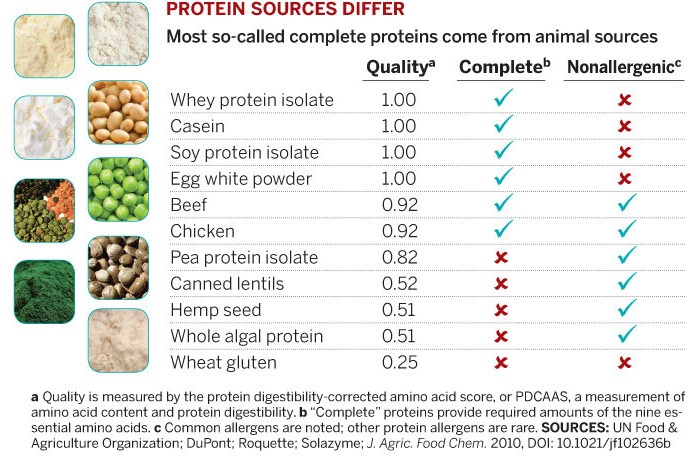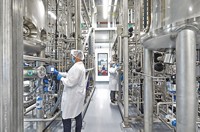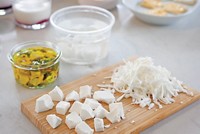Advertisement
Grab your lab coat. Let's get started
Welcome!
Welcome!
Create an account below to get 6 C&EN articles per month, receive newsletters and more - all free.
It seems this is your first time logging in online. Please enter the following information to continue.
As an ACS member you automatically get access to this site. All we need is few more details to create your reading experience.
Not you? Sign in with a different account.
Not you? Sign in with a different account.
ERROR 1
ERROR 1
ERROR 2
ERROR 2
ERROR 2
ERROR 2
ERROR 2
Password and Confirm password must match.
If you have an ACS member number, please enter it here so we can link this account to your membership. (optional)
ERROR 2
ACS values your privacy. By submitting your information, you are gaining access to C&EN and subscribing to our weekly newsletter. We use the information you provide to make your reading experience better, and we will never sell your data to third party members.
Food Ingredients
Calling On Plants To Fulfill Protein’s Promise
As foodmakers add protein to more of the things we eat, could a switch to plant-based proteins help our health and the planet?
by Melody M. Bomgardner
February 9, 2015
| A version of this story appeared in
Volume 93, Issue 6

It used to be that supplemental protein was something only bodybuilders were keen on. But now, even most regular-shaped eaters report they are looking to add more protein to their shopping carts. The macronutrient is super hip thanks to low-carb diet trends and claims that protein can help build lean muscle, keep you full longer, and even help you lose weight.
This so-called health halo seems to persist even though Americans, in particular, already get more than enough protein in their meat-heavy diets. Many nutritionists contend that protein mania is merely a passing fad, but food ingredient firms disagree.
To pack a protein punch, food makers can turn to animal sources such as dried egg whites or milk-derived casein and whey. But the balance is tilting in favor of plant ingredients, a shift that benefits companies such as DuPont, Solazyme, and Roquette.
Executives with those firms say the shift has many causes: rising dairy prices, demand for new ingredients in food and beverages, concerns about sustainability, and the popularity of heart-healthy diets based on plants. Soy is king among plant proteins, but demand is also high for new ingredients derived from peas, other oil seeds, and even algae.
Jump to Topics:
- A Food Trend With Muscle
- Soy Versus the Competition
- Protein Metabolism Interactive Graphic
- Proteins and Health
- Convincing the Carnivores
- Find out how well you know your protein chemistry and trivia with our quiz at http://cenm.ag/proteinquiz.
»To download a pdf of this article, visit http://cenm.ag/plantproteins.
If sellers of plant-based ingredients are able to satisfy consumers’ desire for protein, they can do more than just steal market share from the livestock and dairy industries. A switch to plant proteins by those who can afford meat would go a long way to feeding the growing global population while using fewer of the planet’s resources.
In terms of reputation, protein shines brighter than its fellow macronutrients. “The whole world of carbohydrates and fat is one of controversy and debate,” points out Rachel Cheatham, a nutritional biochemist and food industry consultant. Many consumers feel ill-equipped to sort out good fats from bad, and healthy carbs from unhealthy ones, Cheatham says, so they seek out foods with less baggage.
“The tenet that protein is a cornerstone of a healthy diet, that it helps us feel full and more satisfied, remains constant,” Cheatham says. Surveys show that a majority of Americans say they are trying to eat more protein.
Fitness buffs have been consuming protein in supplement powders for years, but more recently mainstream brands have taken to bragging about protein content on the front of their food packages. Proteins accounted for more than half of the nearly $25 billion market for nutritional and functional ingredients in 2013, making them more popular than vitamins, minerals, or omega-3s, according to the market research firm Frost & Sullivan.
The trend by food makers to supplement all kinds of foods with additional protein is helping drive growth by almost 13% per year. Although the market is dominated by milk- and egg-derived ingredients, soy protein claims a roughly 25% share, and wheat proteins have 10%, Frost & Sullivan says.
Once upon a time, protein was just a fancy way of saying “meat.” But these days, 30% of Americans report they are eating less red meat because of worries about coronary disease and obesity.
“Millennials are driving this category—almost a third consume one or more meat alternatives every day, and around 70% eat them a few times a week,” even though only about 13% are vegetarian or vegan, says William A. Roberts Jr., senior food and drink analyst at the consulting firm Mintel. He adds that the size and spending power of the millennial generation—born between 1980 and 2000—means food makers must cater to them.
Food makers have other reasons to look to plants for protein. One is cost; dairy product prices have been rising since 2006 and hit a peak in 2013, thanks to rising demand from China.
Soy isolates currently cost about $7,000 per metric ton, compared with $11,000 for whey isolates, according to data from the protein technology firm Burcon NutraScience. Soy isolates often take the place of pricier egg or dairy in packaged foods and can be used for thickening, foaming, and emulsifying. They also bind water, fats, and flavorings.
Increasingly, plant proteins’ edge goes beyond just cost. Depending on the food, animal proteins can limit shelf life, add a cheesy taste, or alter appearance. In contrast, food scientists have created new forms of plant proteins that add crispiness to cereals and snack bars or can be blended into a clear beverage.
When it comes to protein sources to innovate with, soy is hard to beat. It is cheap, provides essential amino acids, is widely available, and is vegan. And because soy has been shown to reduce harmful (LDL) cholesterol while maintaining beneficial (HDL) cholesterol, the Food & Drug Administration allows foods with 6.25 g or more of soy protein per serving to carry a heart health claim on the label.

Virtually all soybeans are processed to obtain vegetable oil. Almost all of the remaining protein-rich meal is sold for animal feed. But ingredient makers get their hands on more than 1 million metric tons of it per year, according to Burcon.
Companies commonly produce soy protein isolates via a complicated process called isoelectric precipitation. Their precise recipes are considered prized intellectual property. But all take advantage of the high solubility of legume proteins in alkaline solutions and their low solubility in acidic ones.
First, protein meal is mixed with water and a strong base such as sodium hydroxide. Then, fiber is removed using a centrifuge, and acid is added to the remaining liquid to precipitate the protein. That protein is then further washed to remove minerals and sugars, the pH is neutralized, and the protein is spray dried.
The global market for soy protein ingredients is dominated by DuPont and Archer Daniels Midland, or ADM. DuPont started its soy protein business in the late 1990s with an acquisition from Ralston Purina and has grown it under the brand name Solae. Last year, soy proteins were responsible for roughly a third of DuPont’s Nutrition & Health sales, which totaled $3.5 billion. To get that much soy into food requires a great deal of food science know-how.
DuPont has a large food science research staff at its St. Louis site, according to Jean Heggie, strategic marketing leader, because “there’s always something new coming to the marketplace.” A decade ago, soy was in demand for use in powdered drink supplements or chewy nutrition bars aimed at fitness buffs. Now the soy protein market has moved on to mainstream snacks and ready-to-drink beverages such as smoothies. One major breakthrough, Heggie says, was the development of “crisps or nuggets—texturized pieces that almost look like Rice Krispies.”
Soy protein is now finding its way into “clustered snacks, extruded snacks, crackers, cookies, and other baked foods,” Heggie says. “We are also seeing a lot of interest around breakfast—in hot or cold cereals and waffles.” To serve the so-called meat-analog market, employees have become expert at extruding a polymer-like protein mixture into threads that mimic meat’s texture.
Because of its utility as a thickener, emulsifier, and binder, soy protein can be hard to avoid in packaged foods. Unfortunately for consumers, soy—as well as dairy, eggs, peanuts, and wheat—can cause an allergic response that is triggered by the body’s digestion of the proteins in those foods.
Although food allergies affect only 1–2% of the population, many consumers are wary of eating certain foods they think may trigger inflammation. This spillover effect is why gluten-free foods have become so popular and why competing plant proteins stand a chance against the soy juggernaut.
Other consumers avoid soy because it is likely to be genetically modified. Still others have read or heard that hormones in soy mimic the human hormone estrogen, although research shows soy foods have either no health effect or—in the case of high-soy-consuming Asian populations—can offer protection against cancer.
The good news for soy-avoiders is that there’s a new plant protein in town, one derived from yellow peas grown in Canada and Europe. The pea is not genetically modified, and allergies to it are rare. Another bonus to peas is that, unlike for soy, no hexane is used to remove vegetable oil. All of these features make it popular with food makers who want to satisfy consumers’ desire for a “clean label,” says Neelesh Varde, a senior product manager at Roquette, a French food ingredients firm.

Just like its soy competitors, pea protein isolate is a neutral-tasting and dense protein that can be made into crispy nuggets and spun into meatlike fibers, Varde explains. Some research has suggested that pea protein is easier to digest than other plant proteins. Although it is not considered as high quality a protein as soy, Varde says, it provides a healthy quantity of many amino acids.
Roquette’s work with boutique food companies convinced it that pea protein is moving into the mainstream. The company does not name its customers, but pea protein gained media fame as the egg replacement in a mayonnaise-like product developed by Hampton Creek, a start-up that raised $23 million from venture capitalists last year. And pea protein is teamed up with non-genetically-modified soy in Beyond Meat’s chicken-free strips.
Roquette is now betting big on peas. “We have a production site dedicated to just pea products, including starches, fibers, and proteins, in Vic-sur-Aisne, France, and we’ve invested in the infrastructure to expand our capacity,” Varde says.
Peas are also hot at Vancouver-based Burcon, which specializes in extracting and purifying plant proteins. It has patented processes to make micelles of soy and pea proteins that are not just soluble but also transparent in acidic beverages. The company already licensed its soy technology to ADM and is operating a pilot plant to produce pea protein products.
Next on Burcon’s list for commercialization is canola protein, according to a recent investor presentation. Like soy protein, it is a by-product of vegetable oil production and normally fed to livestock. According to the U.S. Canola Association, canola protein isolates have shown similar functionality to soy and pea proteins. The protein is also high in the amino acid cysteine, which is used by the body to replenish hair and skin.
For consumers who like their plant protein a little less processed, but still convenient and invisible, algae might do the trick. Grown in large, dark fermentation tanks, Solazyme’s gold-colored whole algae protein is not like the green slime found outside in ponds. It’s 65% protein along with fatty acids, fiber, and the carotenoid lutein.
Once dried, the algae retain a portion of the original cell wall. In effect, the algae are preencapsulated, explains Mark Brooks, Solazyme’s vice president of food ingredients. “It is still intact and doesn’t interact with the other ingredients in the food, so it can be included in higher levels or in unfriendly environments, such as one with a low pH,” he says.
↑ Top
You may have issues viewing the interactive image below when using Internet Explorer. Please try another browser.
>>To download a pdf of this article, visit http://cenm.ag/plantproteins.
Proteins and Health
Although most consumers are unfamiliar with algae as food, Brooks stresses that the product is aimed squarely at the mainstream market. “If I put whole algal protein into kids’ Goldfish crackers, I’ve doubled protein and fiber and reduced carbs,” he notes. If the crackers still look like goldfish, “then I’ve got a label that makes a lot of sense.”
Purveyors of protein have a rather easy sales job. Most consumers know that proteins from food provide the amino acids their bodies use to grow and repair tissues. Amino acids are also used to make molecules such as nucleic acids, coenzymes, and hormones. In fact, of 20 amino acids in foods, nine are essential, meaning we need to obtain them directly from proteins in our diet to maintain health.
Around a decade ago, nutrition researchers started exploring a whole new set of benefits for protein in the diet, according to DuPont’s Heggie. “The benefits most strongly associated with protein include that it helps sustain energy levels, manage weight and hunger, protect muscle mass as we age, and helps active people build lean muscle,” she says.
Advertisement
In a review article published in 2008, for example, a team of researchers reported that in controlled diets, moderately increased protein intake helped subjects feel full faster and stay full longer. They burned more calories as heat, and some built or maintained more lean muscle mass instead of storing energy as fat (Am. J. Clin. Nutr.2008, 87, 1558S).
On average, Americans get the majority of their protein from animal sources—meat, eggs, and dairy. These are all considered “high quality,” or complete, proteins because they provide plenty of the nine essential amino acids.
For vegans, however, and people who live in regions where protein sources are scarce, the quality of protein is more of a concern. In fact, soy is the only common plant protein that contains sufficient quantities of the essential amino acids, though all plant proteins contain trace amounts of all of them.
People who eat only plants may not get enough of the essential amino acid lysine, particularly if they don’t eat enough legumes. By eating a steady diet of legumes, which are rich in lysine, and grains, which are high in methionine, plant eaters obtain a complete protein.
On the other end of the spectrum, it is theoretically possible to eat too much protein, though there is no standard upper limit on protein consumption. U.S. guidelines say 10–35% of calories in a healthy diet can come from protein.
But the body has no mechanism for long-term storage of amino acids, so more is not necessarily better. Excess amino acids are broken down by the liver and then treated like other sources of calories—burned as energy or stored as fat. What’s more, excess nitrogen from amino acids is a burden on the kidneys, which filter it out from the blood and excrete it.
People who have kidney disease may be told by their doctors to avoid high-protein diets. “There is some evidence, which is not incontrovertible, that consumption of high-protein diets in patients with pre-existing kidney disease may worsen the disease,” says Allon Friedman, an associate professor at Indiana University School of Medicine. According to the Centers for Disease Control & Prevention, 10% of the U.S. population has some form of chronic kidney disease.
And even most healthy Americans consume more protein than they need. The average American man gets almost twice the recommended minimum of about 2 oz per day for a 160-lb person.
For that reason, the trend of adding protein to breakfast foods, snacks, and beverages is “something that we just don’t need,” says Susan Levin, a dietician and director of nutrition education at the Physicians Committee for Responsible Medicine, a health advocacy group. “The marketing has been very successful, brilliant even, but who are these people that are protein deficient?”
Although most people in the developed world do have access to more than enough protein, the same is not true for the planet as a whole. According to the United Nations, 805 million people, or one in nine on the planet, suffer from hunger.
And as the global population grows to 9 billion or 10 billion by 2050 and incomes rise, demand for food from animal agriculture is expected to nearly double, according to the National Academies. That kind of increase threatens to overwhelm the planet’s land, water, and energy resources. Moreover, raising animals for food releases more greenhouse gases than are emitted from transportation.
Professionals who work in the plant protein industry point out that the resources used to produce just 1 lb of animal protein could instead provide 10 lb of plant protein. The trick is to get consumers in wealthy nations to switch to plant proteins. The hard truth is that food sells on the basis of taste, cost, and healthfulness—in that order.
Even vegetarians and flexitarians—those who often choose vegetable proteins but also eat meat—are rarely moved solely by environmental concerns. Although they often buy meat alternatives, surveys show they aren’t very satisfied with them, according to Mintel’s Roberts. “These products are trying very hard to replicate meat but seem to be missing the target.”
Food researchers have high hopes for future meat substitutes. “We try to see how we can create the fibrous stuff of muscle that you have to chew,” says Fu-hung Hsieh, professor of bioengineering and food science at the University of Missouri.
Hsieh and his team experiment with soy and other plant proteins. They mix them with water inside an extruder. By applying the right amount of heat they can create a gel-like consistency before carefully cooling the mixture to create a laminated mass that is extruded into threads and fibers. Getting a more random, natural appearance and a not-too-tough texture requires “a lot of intuition and guesswork and trial and error,” he says.
The frustration is worth it, Hsieh insists. “If we continue to consume as much animal protein as we do today, there will be a lot of wars to capture more resources.” He says the challenge for scientists is to make plant protein more attractive to consumers, starting with the more flexible ones. Hsieh even holds out a glimmer of hope for winning over meat lovers. “You might get to them,” he says, “if you can give them a steak without them knowing it’s made from plants.”









Join the conversation
Contact the reporter
Submit a Letter to the Editor for publication
Engage with us on Twitter